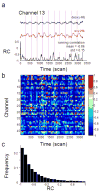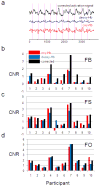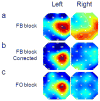Functional near infrared spectroscopy (NIRS) signal improvement based on negative correlation between oxygenated and deoxygenated hemoglobin dynamics
- PMID: 19945536
- PMCID: PMC2818571
- DOI: 10.1016/j.neuroimage.2009.11.050
Functional near infrared spectroscopy (NIRS) signal improvement based on negative correlation between oxygenated and deoxygenated hemoglobin dynamics
Abstract
Near infrared spectroscopy (NIRS) is a promising technology for functional brain imaging which measures hemodynamic signals from the cortex, similar to functional magnetic resonance imaging (fMRI), but does not require the participant to lie motionless in a confined space. NIRS can therefore be used for more naturalistic experiments, including face to face communication, or natural body movements, and is well suited for real-time applications that may require lengthy training. However, improving signal quality and reducing noise, especially noise induced by head motion, is challenging, particularly for real time applications. Here we study the properties of head motion induced noise, and find that motion noise causes the measured oxygenated and deoxygenated hemoglobin signals, which are typically strongly negatively correlated, to become more positively correlated. Next, we develop a method to reduce noise based on the principle that the concentration changes of oxygenated and deoxygenated hemoglobin should be negatively correlated. We show that despite its simplicity, this method is effective in reducing noise and improving signal quality, for both online and offline noise reduction.
Copyright 2009 Elsevier Inc. All rights reserved.
Figures







Similar articles
-
Near-infrared spectroscopy (NIRS) in cognitive neuroscience of the primate brain.Neuroimage. 2005 May 15;26(1):215-20. doi: 10.1016/j.neuroimage.2005.01.055. Neuroimage. 2005. PMID: 15862221
-
Separating heart and brain: on the reduction of physiological noise from multichannel functional near-infrared spectroscopy (fNIRS) signals.J Neural Eng. 2014 Oct;11(5):056010. doi: 10.1088/1741-2560/11/5/056010. Epub 2014 Aug 11. J Neural Eng. 2014. PMID: 25111822 Clinical Trial.
-
Validation of brain-derived signals in near-infrared spectroscopy through multivoxel analysis of concurrent functional magnetic resonance imaging.Hum Brain Mapp. 2017 Oct;38(10):5274-5291. doi: 10.1002/hbm.23734. Epub 2017 Jul 19. Hum Brain Mapp. 2017. PMID: 28722337 Free PMC article.
-
Towards the next generation of near-infrared spectroscopy.Philos Trans A Math Phys Eng Sci. 2011 Nov 28;369(1955):4425-39. doi: 10.1098/rsta.2011.0262. Philos Trans A Math Phys Eng Sci. 2011. PMID: 22006899 Review.
-
Near-Infrared Spectroscopy Imaging for Assessing Skin and Wound Oxygen Perfusion.Clin Podiatr Med Surg. 2018 Jul;35(3):343-355. doi: 10.1016/j.cpm.2018.02.005. Epub 2018 May 3. Clin Podiatr Med Surg. 2018. PMID: 29861017 Review.
Cited by
-
The impact of TMS-enhanced cognitive control on forgiveness processes.Brain Behav. 2021 May;11(5):e02131. doi: 10.1002/brb3.2131. Epub 2021 Mar 30. Brain Behav. 2021. PMID: 33784030 Free PMC article.
-
Neural synchrony predicts children's learning of novel words.Cognition. 2021 Sep;214:104752. doi: 10.1016/j.cognition.2021.104752. Epub 2021 May 6. Cognition. 2021. PMID: 33965782 Free PMC article.
-
Dyad sex composition effect on inter-brain synchronization in face-to-face cooperation.Brain Imaging Behav. 2021 Jun;15(3):1667-1675. doi: 10.1007/s11682-020-00361-z. Brain Imaging Behav. 2021. PMID: 32761565
-
Exclusive detection of cerebral hemodynamics in functional near-infrared spectroscopy by reflectance modulation of the scalp surface.J Biomed Opt. 2020 Aug;25(8):1-16. doi: 10.1117/1.JBO.25.8.087001. J Biomed Opt. 2020. PMID: 32762174 Free PMC article.
-
Exploration of resting-state brain functional connectivity as preclinical markers for arousal prediction in prolonged disorders of consciousness: A pilot study based on functional near-infrared spectroscopy.Brain Behav. 2024 Aug;14(8):e70002. doi: 10.1002/brb3.70002. Brain Behav. 2024. PMID: 39183500 Free PMC article.
References
-
- Bauernfeind G, Leeb R, Wriessnegger SC, Pfurtscheller G. Development, set-up and first results for a one-channel near-infrared spectroscopy system. Biomedizinische Technik. Biomedical engineering. 2008;53:36–43. - PubMed
-
- Boas DA, Strangman G, Culver JP, Hoge RD, Jasdzewski G, Poldrack RA, Rosen BR, Mandeville JB. Can the cerebral metabolic rate of oxygen be estimated with near-infrared spectroscopy? Physics in medicine and biology. 2003;48:2405–18. - PubMed
-
- Buxton RB, Uludag K, Dubowitz DJ, Liu TT. Modeling the hemodynamic response to brain activation. Neuroimage. 2004;23(Suppl 1):S220–33. - PubMed
-
- Buxton RB, Wong EC, Frank LR. Dynamics of blood flow and oxygenation changes during brain activation: the balloon model. Magnetic resonance in medicine. 1998;39:855–64. - PubMed
Publication types
MeSH terms
Substances
Grants and funding
LinkOut - more resources
Full Text Sources
Other Literature Sources
Medical

